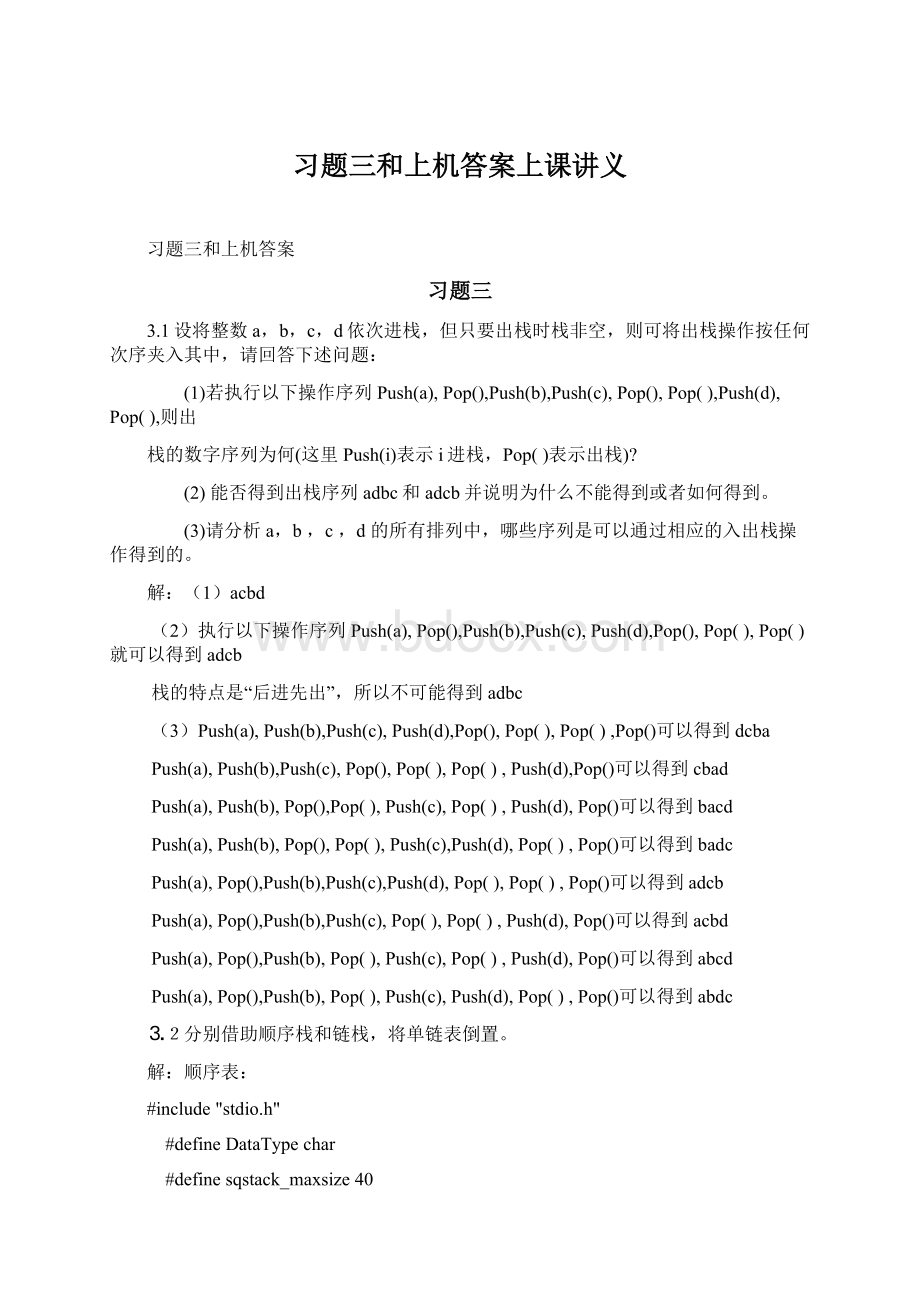习题三和上机答案上课讲义.docx
《习题三和上机答案上课讲义.docx》由会员分享,可在线阅读,更多相关《习题三和上机答案上课讲义.docx(17页珍藏版)》请在冰豆网上搜索。

习题三和上机答案上课讲义
习题三和上机答案
习题三
3.1设将整数a,b,c,d依次进栈,但只要出栈时栈非空,则可将出栈操作按任何次序夹入其中,请回答下述问题:
(1)若执行以下操作序列Push(a),Pop(),Push(b),Push(c),Pop(),Pop(),Push(d),Pop(),则出
栈的数字序列为何(这里Push(i)表示i进栈,Pop()表示出栈)?
(2)能否得到出栈序列adbc和adcb并说明为什么不能得到或者如何得到。
(3)请分析a,b,c,d的所有排列中,哪些序列是可以通过相应的入出栈操作得到的。
解:
(1)acbd
(2)执行以下操作序列Push(a),Pop(),Push(b),Push(c),Push(d),Pop(),Pop(),Pop()就可以得到adcb
栈的特点是“后进先出”,所以不可能得到adbc
(3)Push(a),Push(b),Push(c),Push(d),Pop(),Pop(),Pop(),Pop()可以得到dcba
Push(a),Push(b),Push(c),Pop(),Pop(),Pop(),Push(d),Pop()可以得到cbad
Push(a),Push(b),Pop(),Pop(),Push(c),Pop(),Push(d),Pop()可以得到bacd
Push(a),Push(b),Pop(),Pop(),Push(c),Push(d),Pop(),Pop()可以得到badc
Push(a),Pop(),Push(b),Push(c),Push(d),Pop(),Pop(),Pop()可以得到adcb
Push(a),Pop(),Push(b),Push(c),Pop(),Pop(),Push(d),Pop()可以得到acbd
Push(a),Pop(),Push(b),Pop(),Push(c),Pop(),Push(d),Pop()可以得到abcd
Push(a),Pop(),Push(b),Pop(),Push(c),Push(d),Pop(),Pop()可以得到abdc
⒊2分别借助顺序栈和链栈,将单链表倒置。
解:
顺序表:
#include"stdio.h"
#defineDataTypechar
#definesqstack_maxsize40
typedefstructsqstack
{DataTypedata[sqstack_maxsize];
inttop;
}SqStackTp;
intInitStack(SqStackTp*sq)
{sq->top=0;return
(1);}
intPush(SqStackTp*sq,DataTypex)
{
if(sq->top==sqstack_maxsize-1)
{printf("栈满");return(0);}
else
{sq->top++;sq->data[sq->top]=x;return
(1);}
}
intPop(SqStackTp*sq,DataType*x)
{
if(sq->top==0){printf("下溢");return(0);}
else{*x=sq->data[sq->top];sq->top--;return
(1);}
}
intEmptyStack(SqStackTp*sq)
{
if(sq->top==0)return
(1);
elsereturn(0);
}
/*主函数*/
voidmain()
{SqStackTpsq;
DataTypech;
InitStack(&sq);
for(ch='A';ch<='A'+12;ch++)
{Push(&sq,ch);printf("%c",ch);}
printf("\n");
while(!
EmptyStack(&sq))
{Pop(&sq,&ch);printf("%c",ch);}
printf("\n");
}
链表:
#include"stdio.h"
#definedatatypechar
#definesizesizeof(structnode)
typedefstructnode
{datatypedata;
structnode*next;
}*LStackTp;
voidInitStack(LStackTp*ls)
{
*ls=NULL;
}
voidPush(LStackTp*ls,datatypex)
{LStackTpp;
p=(LStackTp)malloc(size);
p->data=x;
p->next=*ls;
*ls=p;
}
intPop(LStackTp*ls,datatype*x)
{LStackTpp;
if((*ls)!
=NULL)
{p=*ls;*x=p->data;*ls=(*ls)->next;
free(p);return
(1);
}elsereturn(0);
}
intEmptyStack(LStackTpls)
{
if(ls==NULL)return
(1);
elsereturn(0);
}
voidmain()
{LStackTpls;
datatypech;
InitStack(ls);
for(ch='A';ch<='A'+12;ch++)
{Push(&ls,ch);printf("%c",ls->data);}
printf("\n");
while(!
EmptyStack(ls))
{Pop(&ls,&ch);printf("%c",ch);}
printf("\n");
}
⒊3有两个栈A,B这两个栈中分别存储这一个升序数列,现要求编写算法把这两个栈中的数合成一个升序队列
解:
linkmerge(linka,linkb)
{linkh,s,m,n,t;
h=(cnode*)malloc(sizeof(cnode));
h->next=NULL;
s=h;
m=a;
n=b;
while(m->next&&n->next)
{if(m->next->datanext->data)
{t=m->next;
m->next=t->next;
t->next=s->next;
s->next=t;
s=t;
}
elseif(m->next->data==n->next->data)
{t=m->next;
m->next=t->next;
n=n->next;
t->next=s->next;
s->next=t;
s=t;
}
else
{t=n->next;
n->next=t->next;
t->next=s->next;
s->next=t;
s=t;
}
}
while(m->next)
{t=m->next;
m->next=t->next;
t->next=s->next;
s->next=t;
s=t;
}
while(n->next)
{t=n->next;
n->next=t->next;
t->next=s->next;
s->next=t;
s=t;
}
free(m);
free(n);
returnh;
}
⒊4设两个栈共享一个数组空间,其类型定义见⒊⒈2节,试写出两个栈公用的读栈顶元算法elemtptop_dustack(dustacktpds,p;inti);进栈操作算法voidpush_dustack(dustacktpds,p;inti,elemtpx);及出栈算法elemtppop_dustack(dustacktpds,p;inti)。
其中i的取值是1或2,用以指示栈号。
解:
读栈顶元函数
elemtptop_sqstack(s:
sqstacktp){
if(s.top==0)
return(null);
else
return(s.elem[s.top]);
}
进栈操作
voidpush_sqstack(sqstacktps,elemtpx){
若栈s未满,将元素x压入栈中;否则,栈的状态不变并给出出错信息
if(s.top==maxsize)
printf(“Overflow”);
else{
s.top++;栈顶指针加1
s.elem[s.top]=xx进栈
}
}
出栈函数
elemtppop_sqstack(sqstacktps){
若栈s不空,则删去栈顶元素并返回元素值,否则返回空元素NULL
if(s.top==0)
return(null);
else{
s.top--;栈顶指针减1
teturn(s.elem[s.top+1]);返回原栈顶元素值
}
}
⒊5假设以数组sequ(0..m-1)存放循环队列元素,同时设变量rear和quelen分别指示循环队列中队尾元素和内含元素的个数。
试给出此循环队列的队满条件,并写出相应的入队列和出队列的算法(在出队列的算法中要返回队头元素)。
解:
队满的条件
(sq.rear+1)MODmaxsize=sq.front
入队列操作
voiden_cqueue(cqueuetpcq,elemtpx){
若循环队列cq未满,插入x为新的队尾元素;否则队列状态不变并给出错误信息
if((cq.rear+1)MODmaxsize==cq.front)
printf(“Overflow”);
else{
cq.rear=(cq.rear+1)MODmaxsize;
cq.elem[cq.rear]=x
}
}
出队列函数
elemtpdl_cqueue(VARcq:
cqueuetp){
若循环队列cq不空,则删去队头元素并返回元素值;否则返回空元素NULL
if(cq.front==cq.rear)
return(NULL);
else{
cq.front=(cq.front+1)MODmaxsize;
return(cq.elem[cq.front]);
}
}
⒊6假设以带头结点的环形链表表示队列,并且只设一个指针指向队尾元素结点(注意不设头指针),试编写相应的初始化队列、入队列、出队列的算法。
解:
初始化:
voidinit_lqueue(lqueuetplq){
设置一个空的链队列lq
new(lq.front);
lq.front->next:
=NIL;
lq.rear=lq.front;
}
入队列操作:
PROCen_lqueue(V